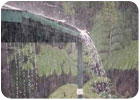
Rainwater harvesting, or the collection of rainwater for later use, could be more than a drop in the water-conservation bucket for Southern California.
That's why five of University of California, Riverside's (UCR) newest alumni in chemical and environmental engineering returned to campus following the New Year's holiday to do manual labor - installing catch basins, piping, downspouts and storage tanks at the Bourns College of Engineering at UCR.
Their concept has attracted regional and national attention. The Metropolitan Water District of Southern California (MWD) and the U.S. Environmental Protection Agency each have awarded the group $10,000 grants.
Now group members Andrew Chin, Roland Cusick, Steven Gebelin, Greg Guillen and Temi Ogunyoku are building a prototype system on the roof of Bourns Hall that will collect store and use collected rainwater to irrigate the lawns around the Bourns College of Engineering at UCR. They are working with advisors Kawai Tam, a lecturer in the Department of Chemical and Environmental Engineering, and College of Engineering associate dean Mark Matsumoto.
The group will present its findings to the MWD in late February and will compete in Washington D.C. on May 9 and 10 against 40 other student design teams. At stake are a top rating by a panel of National Academy of Sciences judges, a $75,000 development grant for the winning concept and receipt of the national P3 (People, Progress and the Planet) Award.
UCR team members developed their idea from an offhand remark made during a discussion about an upcoming class project.
“Temi jokingly came up with the idea of using Dixie cups to collect water and that lead, through our discussions with Dr. Matsumoto, to the idea of rainwater harvesting,” says Cusick. “The problem was that, as Southern California gets paved over, we're diverting more of our rainwater to runoff and less is getting into ground water.”
“We started discussing clean water sources and realized the closest source was rainfall and its first contact is rooftops,” adds Guillen.
“This project has the potential to work with the technologies and resources of many developing countries' governments,” says Ogunyoku.
This seemingly simple project is complicated by the fact that all the team members have received their bachelor's degrees from UCR and are moving on in their careers.

The group looked at Ontario, Calif., as their model because of its rapid growth, adequate rainfall and large numbers of warehouses and distribution centers with large roof surface areas. Currently, Ontario gets 70 percent of its water from underground aquifers and buys the other 30 percent from MWD.
Ontario is one of eight municipal water suppliers operating under the auspices of the Inland Empire Utilities Agency. The agency has set a goal of saving, through conservation, more than 25,000 acre-feet of water, or about seven percent of current use, for the next 20 years.
The UCR group thinks rainwater harvesting can help meet those goals, and can be used in other countries where water scarcity exists, but they have to have solid numbers, and that's where the Bourns Hall experiment comes in.
Computer models suggest that in the last five years (2000-2004) the college's 795-square-foot lawn could be irrigated solely using rainwater for 237 days, or 65 percent of the year. That amounts to an annual savings of about $955 to the college's water bill over those five years.
For the City of Ontario, the group thinks rainwater harvesting could ideally collect more than 2,200 acre-feet of water per year, enough to meet the domestic water needs of nearly 10,000 people annually. ND


Report Abusive Comment